Content
Published:
This is an archived release.
Car usage increases
Norwegian vehicles were driven 44.3 billion kilometres on Norwegian and international roads in 2015; 1.2 per cent more than in 2014. The total mileage for passenger cars increased by 1.8 per cent in the same period; 34.4 billion kilometres.
| Vehicle-kilometres (million kms) | Share | Per cent | ||
|---|---|---|---|---|
| 2014 - 2015 | 2010 - 2015 | |||
| 2015 | ||||
| All vehicles | 44 250 | 100.0 | 1.2 | 4.0 |
| All passenger cars | 34 435 | 77.8 | 1.8 | 5.2 |
| All buses | 564 | 1.3 | -1.3 | -9.3 |
| All vans and small lorries | 7 287 | 16.5 | -1.1 | -1.4 |
| All heavy lorries and road tractors | 1 964 | 4.4 | 0.2 | 8.5 |
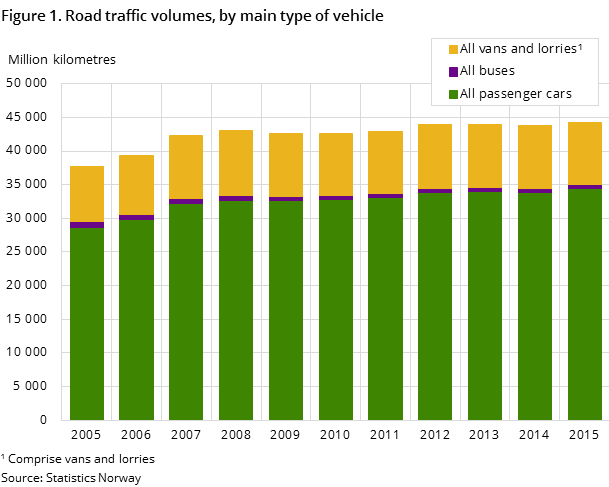
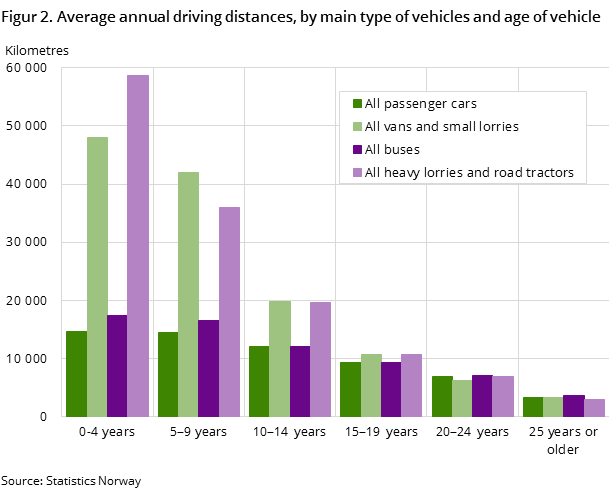
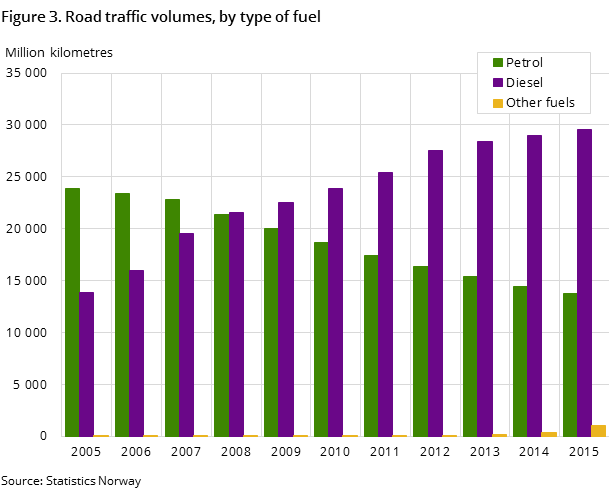
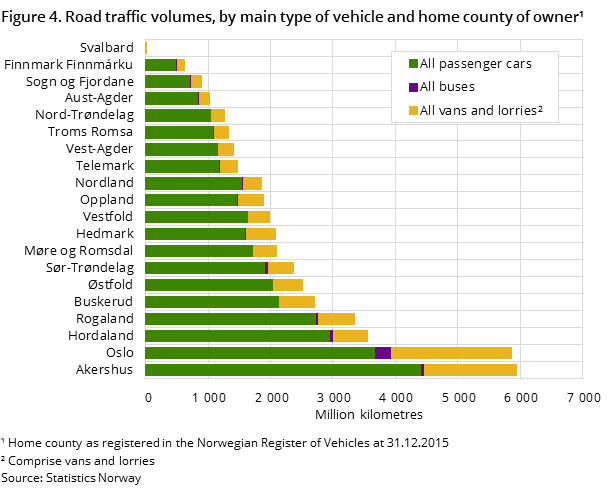
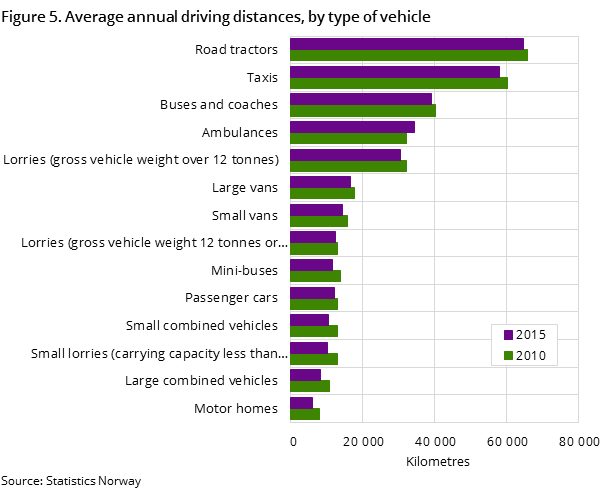
Passenger cars accounted for a good 78 per cent of the total driving by Norwegian vehicles last year. After passenger cars, small vans were driven the most in 2015. This group accounted for 16.5 per cent of total kilometres driven in 2015, with 7.3 billion kilometres. This was 1.1 per cent less than in 2014. The large vans’ share of the total road traffic was 4.4 per cent, amounting to 2.0 billion kilometres. This was a slight increase of 0.2 per cent compared with the previous year. For buses, minibuses led to a decrease in mileage of 1.3 per cent.
Lower average mileage
Under passenger car vehicles, taxis had the highest average; with an average yearly mileage of 57 905 kilometres; 1 000 kilometres less than the year before. The vehicle group with the highest average was road tractors, with 64 696 kilometres in 2015. This was 716 kilometres more than in 2014.
New cars are driven the most
The average mileage for passenger cars decreased little in the first ten years. For trucks and buses, the average mileage fell significantly after the first four years of life. Heavy lorries newer than five years drove for example an average of nearly 59 000 kilometres per year during the first years of life. The average mileage for lorries between five and nine years old fell to 36 000 kilometres.
Slight increase in diesel share
Diesel-powered vehicles amounted 66.7 per cent of total kilometres driven in 2015; 0.5 percentage points more than the year before. The average yearly mileage is also higher for diesel cars. While a gasoline-powered passenger car was driven 9 502 kilometres on average in 2015; diesel-powered cars were driven 15 494 kilometres.
Number of electric cars growing rapidly
The number of electric cars is increasing rapidly in Norway, but still only amounted to 2.6 per cent of the vehicle fleet at the end of last year. In 2015, electric vehicles’ total mileage was estimated at 939 million kilometres. This gives an average yearly mileage of 13 100 kilometres. For electric passenger cars, the average mileage estimated was 12 987 kilometres.
New calculation of mileage for electric cars in 2015Open and readClose
Statistics on mileage are based on meter reading data from the EEA controls (periodic vehicle inspection) that Statistics Norway receives annually from the Norwegian Public Roads Administration. The date of the first control of a new car depends on the vehicle group. For passenger cars, the first control is held after 4 years, while a lorry is called after one year. Calculating mileage for cars that have not yet had their first control is based on a model. For more details about the model used see About the statistics. The rapid development in the number and type of electric vehicles means that the model is not optimum for calculating mileage for electric vehicles. For 2015, Statistics Norway has therefore obtained additional information from dealers and the Norwegian Electric Vehicle Association, which is conducting a survey on the mileage for these cars. This information has been embedded in the model. This has meant that the average mileage for electric cars has increased significantly compared to previous calculations. For 2015, the average mileage for electric passenger cars is estimated at 12 987 kilometres, compared with 7 800 for 2014. Until we have more actual meter readings there will be uncertainties in the estimates of mileage for electric vehicles.
Mileage broken down by county and municipalityOpen and readClose
The distribution of mileage by the owners’ county of residence and municipality of residence largely follows the population of the counties and municipalities, with some variations in the average mileage and average number of cars per capita between different parts of the country. However, there is not necessarily agreement between the owner’s address and the place where the vehicle is driven. For example, vehicles owned by leasing companies or large transport and service companies will usually be registered under the address of the head office, even although they are used in other parts of the country. At the municipal level, such conditions have a particular impact on vehicles registered on owners in Baerum, since several large leasing companies are located there.
Contact
-
Henrik Bråthen
E-mail: henrik.brathen@ssb.no
tel.: (+47) 40 81 14 03
-
Geir Martin Pilskog
E-mail: geir.martin.pilskog@ssb.no
tel.: (+47) 40 81 13 83
-
Nataliya Granerud
E-mail: nataliya.granerud@ssb.no
tel.: (+47) 40 81 13 96
